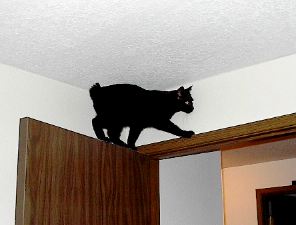Renowned for their lack of a tail, the Manx cat is prized for their hunting skills, yet are considered to be tame and sociable cats, getting along well with people in their lives and providing their families with fun years of companionship. This feline is highly intelligent, active, and frisky, often deemed to have a “dog-like” personality due to their love of play and the devotion they give to their loving families.
Origin of the Manx Cat
The Manx cat is one of the oldest known breeds in the cat fancy, with its origin being shrouded by many tales. One interesting legend talks about how the breed became tailless. It is said that the Manx cat was cozily sleeping when Noah alerted all the animals to come into the ark. Fortunately, the Manx cat roused and made it in time in the ark, but Noah closed the door, cutting its tail.
However, more accurate records data from history shows that the Manx have originated on an island between Ireland and Britain called the Isle of Man. It is believed that a tailless cat might have accidentally ridden a shipping vessel to the island, and then spread its genes towards the other cats in the area. Soon, the island became renowned for these tailless furballs.
The Manx cat was one of the first cat breeds showcased on the first shows conducted by the Cat Fanciers’ Association in the 1900s. Today, the Manx cat is now recognized by major cat associations.
Physical Characteristics of the Manx Cat
Length: 14 to 16 inches
Weight: 9 to 13 pounds (Males), 7 to 11 pounds (Females)
Life Expectancy: 8 to 14 years
Coat Color: Black, white, blue, red, cream, silver, plus different shadings and patterns
Type of Coat: Short, dense, and glossy, or Long, dense, soft, and silky
Eye Color: Gold, green, hazel, blue, copper, or odd-eyed
The Manx is a roundish stocky cat, with a round head, eyes, rump, and whisker pads. Its powerful hind legs are higher than the front legs, which is pretty evident whenever it is standing.
While known for their lack of their tail, not all Manx cats are entirely tailless. Rumpy Risers have a small bumpy rising tail on their rump. Stumpies have a little stump tail. On the other hand, Rumpies are the one entirely lacking the tail, no protuberance or stopping motion even if the hand is sled down their rump. In terms of coat, some Manx will sport a short, thick, dense coat. The long-haired Manx, called Cymric, have medium, soft, silky fur.
Manx Cat Personality
With their ancestors living an island life, the Manx cat retains their incredible hunting skills and alert demeanor. Having them around is seemingly like having a watchcat that would react, growl and even attack anything unfamiliar or something it deems as a threat. However, if they notice that you are not alarmed by the situation, they know when to calm down and relax.
Manx cats are pretty adaptable and will adjust to any home or family. They are open to meeting new individuals, greeting them with a cheek rub or gentle head bump.
These felines have a laid-back personality and enjoy peaceful environments. However, they also have their fun-loving side and would be happy to follow their owners and get involved with any activity they are doing. Once their families are ready to relax, they show their affectionate side, curling in their master’s lap, sitting anywhere close to keep an eye on them, and communicating through trills rather than meows.
As a highly intelligent breed, the Manx cat can quickly learn their name, grasp new tricks, or walk on leash. They can also learn how to do things their owners don’t wish these furballs know, such as opening cabinets or the faucet. They have an innate love for water, given that they are island cats after all.
Caring for the Manx Cat
Manx cats come in two hair virtues, the shorthair and longhair. The short-haired Manx cats sport an outer coat, which tends to be hard and shiny. Meanwhile, the Cymric or the long-haired has a medium, silky coat. Either way, both cats possess double coats, which requires once to twice brushing a week to remove dirt, debris, and dead hair and keep their coat in tip-top condition.
Given their powerful hind legs, they are excellent jumpers and can reach great heights. High perches and cat trees are suitable investments. Otherwise, they can be seen perching upon shelves, tables, and furniture.
As an active breed, Manx cats will be happiest in active homes. They love to run, seemingly like balls rolling around the room. With that, they need people that would spend ample time playing and interacting with them. A game of fetch is an excellent way to consume their energy as these felines tend to be excellent retrievers.
If introduced properly, Manx cats are also amenable to live harmoniously with children and other pets. As long as they are treated with respect and their authority is observed, they can get along well with toddlers and leave other pets along.
In terms of health, Manx cats are generally sturdy. Still, they may be vulnerable to corneal dystrophy, tailbone arthritis, and the Manx syndrome, characterized by an array of congenital disabilities, such as a short spine, digestion and bowel issues, and urinary tract problems. Proper immunizations and regular consultations may help in detecting or preventing any condition.
Manx cats are ideal for families that are looking for dog-like furballs to add to their lovely homes. If showered with the attention they deserve, this placid yet safeguarding feline is ready to repay its families with devotion and protection.


